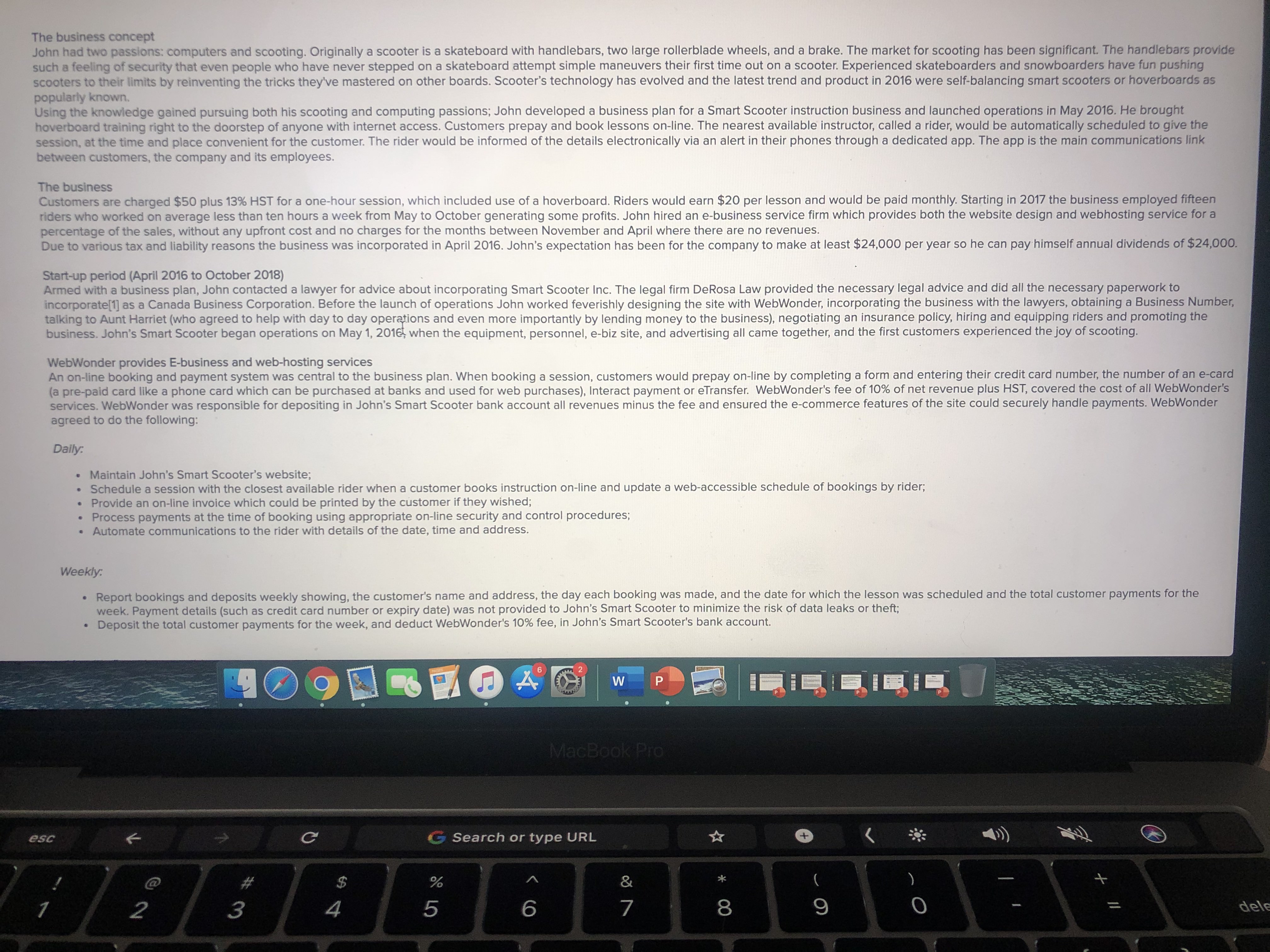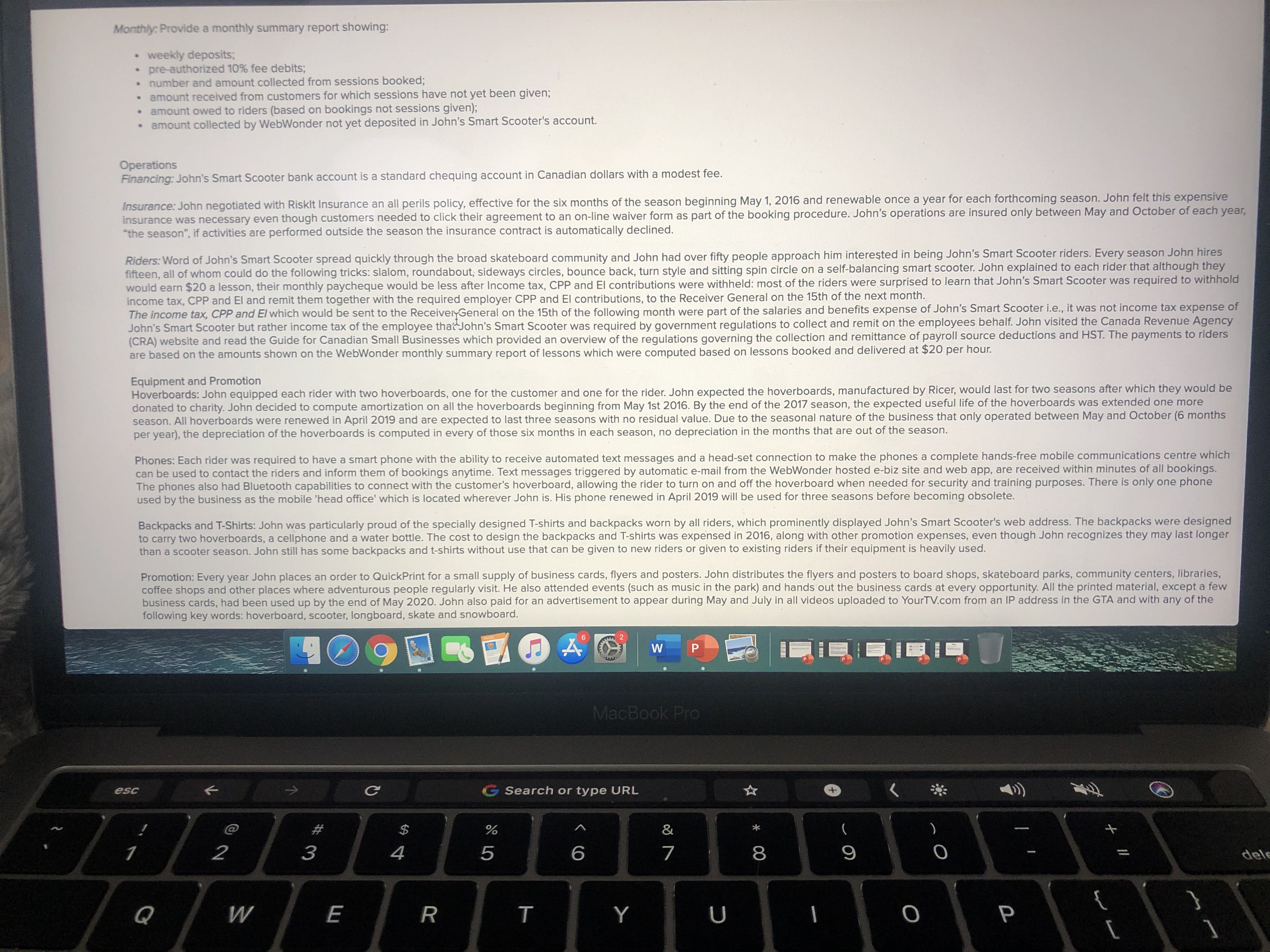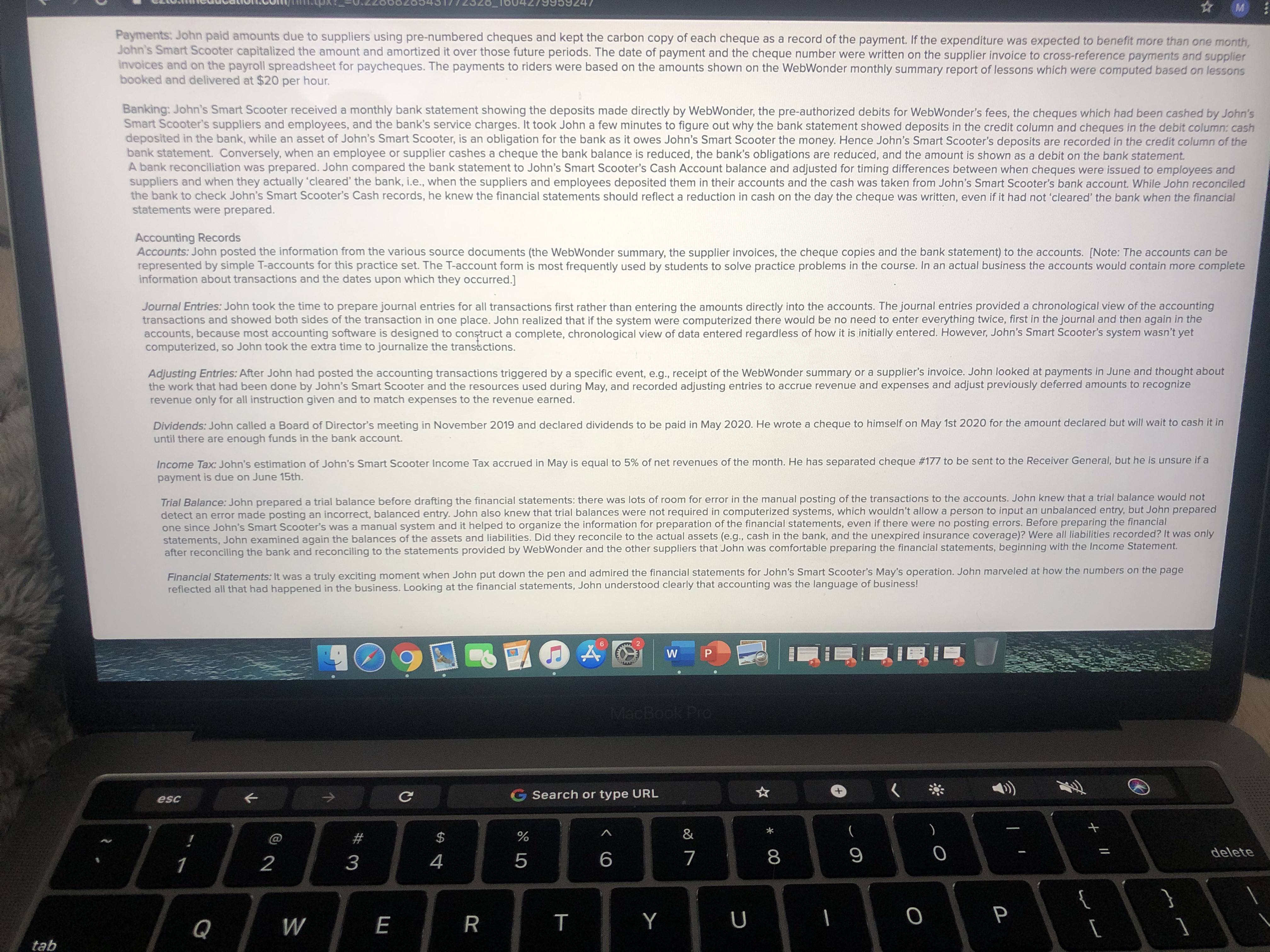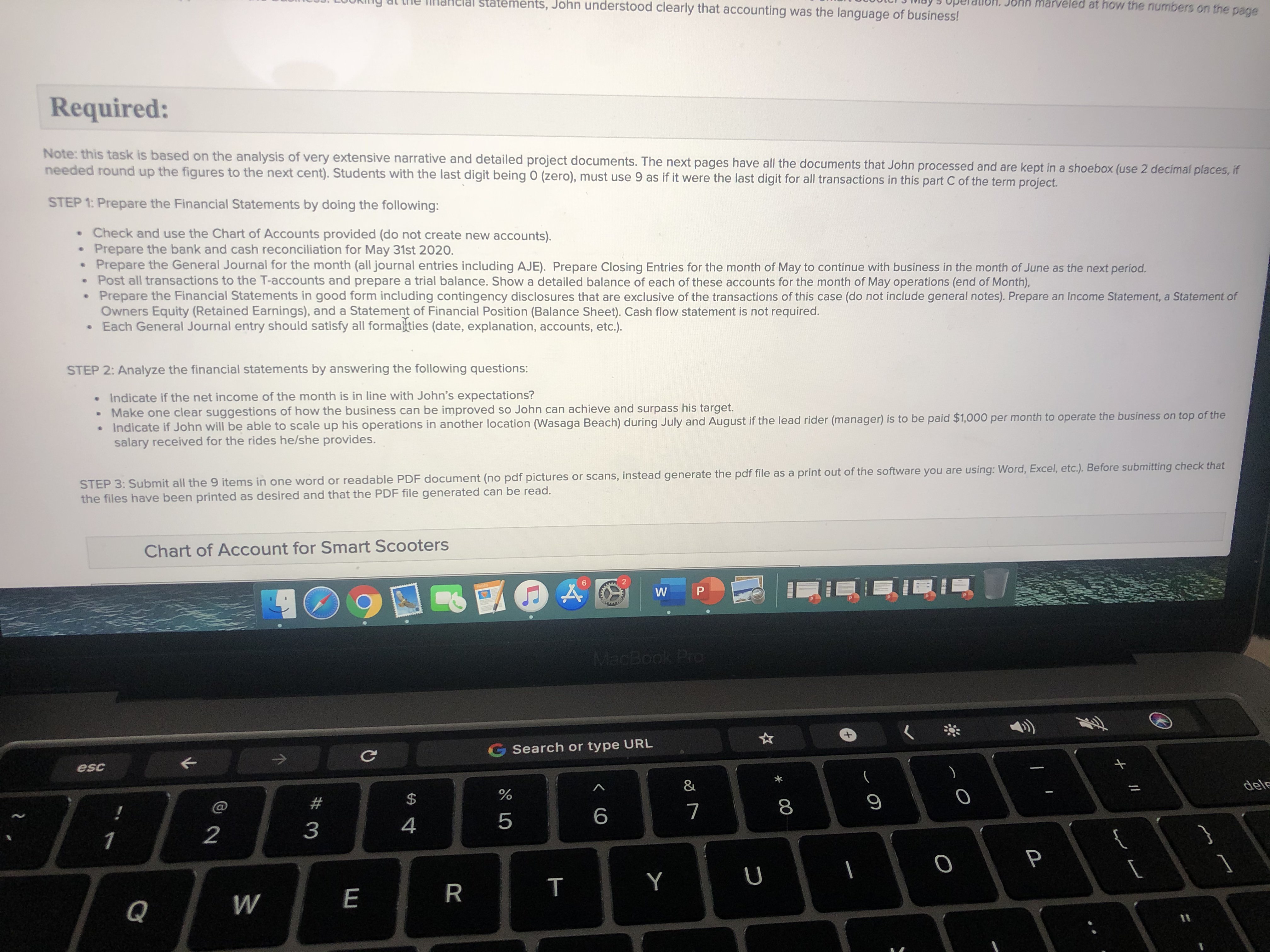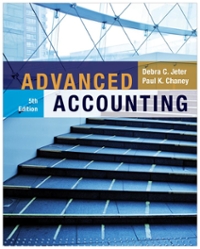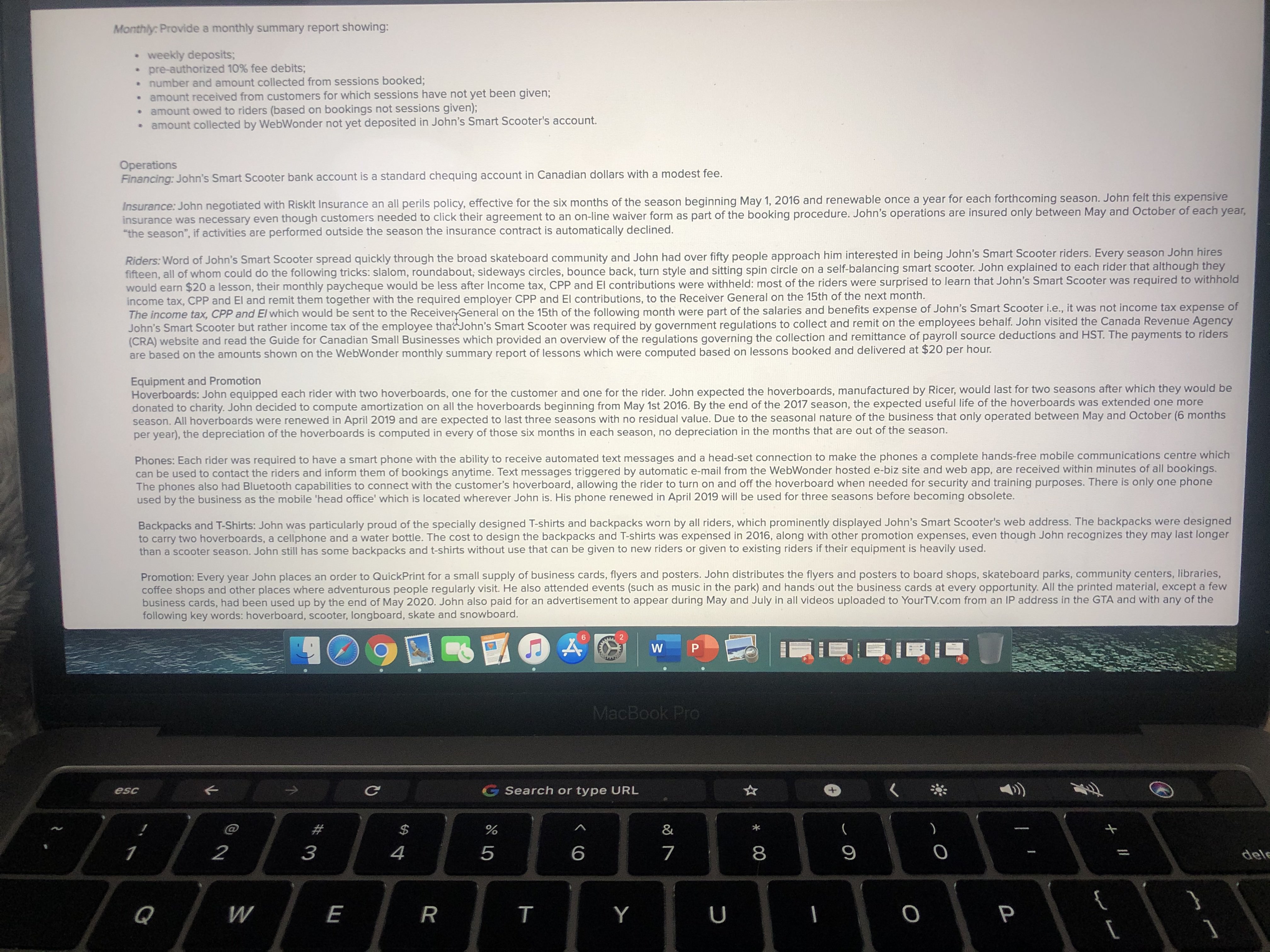
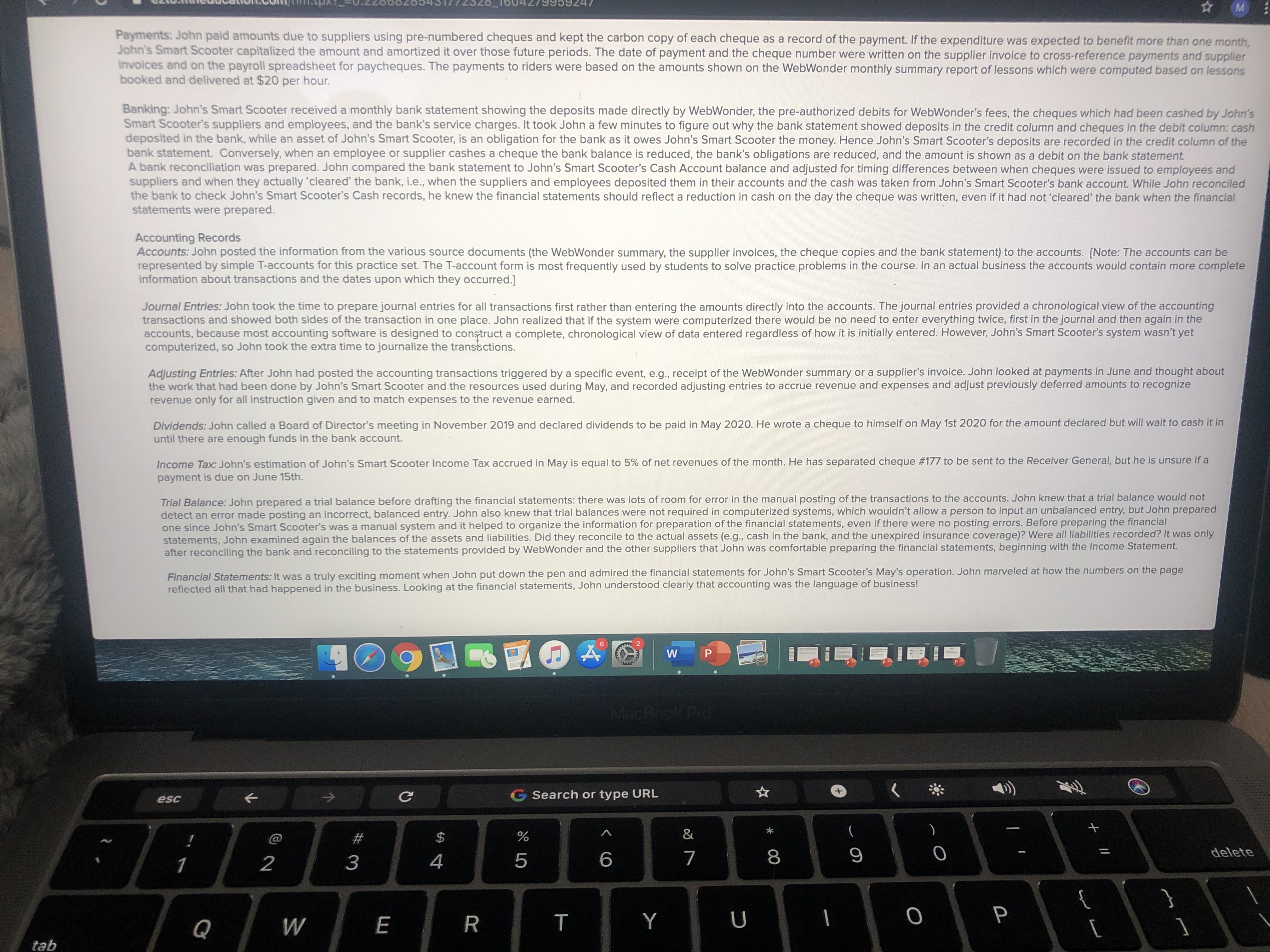

this is a sample question that i cant do for my test prep, please answer with full guidance! thank you
The business concept John had two passions: computers and scooting. Originally a scooter is a skateboard with handlebars, two large rollerblade wheels, and a brake. The market for scooting has been significant. The handlebars provide such a feeling of security that even people who have never stepped on a skateboard attempt simple maneuvers their first time out on a scooter. Experienced skateboarders and snowboarders have fun pushing scooters to their limits by reinventing the tricks they've mastered on other boards. Scooter's technology has evolved and the latest trend and product in 2016 were self-balancing smart scooters or hoverboards as popularly known. Using the knowledge gained pursuing both his scooting and computing passions; John developed a business plan for a Smart Scooter instruction business and launched operations in May 2016. He brought hoverboard training right to the doorstep of anyone with internet access. Customers prepay and book lessons on-line. The nearest available instructor, called a rider, would be automatically scheduled to give the session, at the time and place convenient for the customer. The rider would be informed of the details electronically via an alert in their phones through a dedicated app. The app is the main communications link between customers, the company and its employees. The business Customers are charged $50 plus 13% HST for a one-hour session, which included use of a hoverboard. Riders would earn $20 per lesson and would be paid monthly. Starting in 2017 the business employed fifteen riders who worked on average less than ten hours a week from May to October generating some profits. John hired an e-business service firm which provides both the website design and webhosting service for a percentage of the sales, without any upfront cost and no charges for the months between November and April where there are no revenues. Due to various tax and liability reasons the business was incorporated in April 2016. John's expectation has been for the company to make at least $24,000 per year so he can pay himself annual dividends of $24,000. Start-up period (April 2016 to October 2018) Armed with a business plan, John contacted a lawyer for advice about incorporating Smart Scooter Inc. The legal firm DeRosa Law provided the necessary legal advice and did all the necessary paperwork to incorporate[1] as a Canada Business Corporation. Before the launch of operations John worked feverishly designing the site with WebWonder, incorporating the business with the lawyers, obtaining a Business Number, talking to Aunt Harriet (who agreed to help with day to day operations and even more importantly by lending money to the business), negotiating an insurance policy, hiring and equipping riders and promoting the business. John's Smart Scooter began operations on May 1, 2012, when the equipment, personnel, e-biz site, and advertising all came together, and the first customers experienced the joy of scooting. WebWonder provides E-business and web-hosting services An on-line booking and payment system was central to the business plan. When booking a session, customers would prepay on-line by completing a form and entering their credit card number, the number of an e-card (a pre-paid card like a phone card which can be purchased at banks and used for web purchases), Interact payment or eTransfer. WebWonder's fee of 10% of net revenue plus HST, covered the cost of all WebWonder's services. WebWonder was responsible for depositing in John's Smart Scooter bank account all revenues minus the fee and ensured the e-commerce features of the site could securely handle payments. WebWonder agreed to do the following: Daily Maintain John's Smart Scooter's website; Schedule a session with the closest available rider when a customer books instruction on-line and update a web-accessible schedule of bookings by rider; . Provide an on-line invoice which could be printed by the customer if they wished; . Process payments at the time of booking using appropriate on-line security and control procedures; . Automate communications to the rider with details of the date, time and address. Weekly: . Report bookings and deposits weekly showing, the customer's name and address, the day each booking was made, and the date for which the lesson was scheduled and the total customer payments for the week. Payment details (such as credit card number or expiry date) was not provided to John's Smart Scooter to minimize the risk of data leaks or theft; Deposit the total customer payments for the week, and deduct WebWonder's 10% fee, in John's Smart Scooter's bank account. 9 A W MacBook Pro esc G Search or type URL + @ # 2 3 6 O delMonthly: Provide a monthly summary report showing: . weekly deposits; pre-authorized 10% fee debits; . number and amount collected from sessions booked; amount received from customers for which sessions have not yet been given; amount owed to riders (based on bookings not sessions given); . amount collected by WebWonder not yet deposited in John's Smart Scooter's account. Operations Financing: John's Smart Scooter bank account is a standard chequing account in Canadian dollars with a modest fee. Insurance: John negotiated with Riskit Insurance an all perils policy, effective for the six months of the season beginning May 1, 2016 and renewable once a year for each forthcoming season. John felt this expensive insurance was necessary even though customers needed to click their agreement to an on-line waiver form as part of the booking procedure. John's operations are insured only between May and October of each year, "the season", if activities are performed outside the season the insurance contract is automatically declined. Riders: Word of John's Smart Scooter spread quickly through the broad skateboard community and John had over fifty people approach him interested in being John's Smart Scooter riders. Every season John hires fifteen, all of whom could do the following tricks: slalom, roundabout; sideways circles, bounce back, turn style and sitting spin circle on a self-balancing smart scooter. John explained to each rider that although they would earn $20 a lesson, their monthly paycheque would be less after Income tax, CPP and El contributions were withheld: most of the riders were surprised to learn that John's Smart Scooter was required to withhold income tax, CPP and El and remit them together with the required employer CPP and El contributions, to the Receiver General on the 15th of the next month. The income tax, CPP and El which would be sent to the ReceiveryGeneral on the 15th of the following month were part of the salaries and benefits expense of John's Smart Scooter i.e., it was not income tax expense of John's Smart Scooter but rather income tax of the employee that John's Smart Scooter was required by government regulations to collect and remit on the employees behalf. John visited the Canada Revenue Agency (CRA) website and read the Guide for Canadian Small Businesses which provided an overview of the regulations governing the collection and remittance of payroll source deductions and HST. The payments to riders are based on the amounts shown on the WebWonder monthly summary report of lessons which were computed based on lessons booked and delivered at $20 per hour. Equipment and Promotion Hoverboards: John equipped each rider with two hoverboards, one for the customer and one for the rider. John expected the hoverboards, manufactured by Ricer, would last for two seasons after which they would be donated to charity. John decided to compute amortization on all the hoverboards beginning from May ist 2016. By the end of the 2017 season, the expected useful life of the hoverboards was extended one more season. All hoverboards were renewed in April 2019 and are expected to last three seasons with no residual value. Due to the seasonal nature of the business that only operated between May and October (6 months per year), the depreciation of the hoverboards is computed in every of those six months in each season, no depreciation in the months that are out of the season. Phones: Each rider was required to have a smart phone with the ability to receive automated text messages and a head-set connection to make the phones a complete hands-free mobile communications centre which can be used to contact the riders and inform them of bookings anytime. Text messages triggered by automatic e-mail from the WebWonder hosted e-biz site and web app, are received within minutes of all bookings. The phones also had Bluetooth capabilities to connect with the customer's hoverboard, allowing the rider to turn on and off the hoverboard when needed for security and training purposes. There is only one phone used by the business as the mobile 'head office' which is located wherever John is. His phone renewed in April 2019 will be used for three seasons before becoming obsolete. Backpacks and T-Shirts: John was particularly proud of the specially designed T-shirts and backpacks worn by all riders, which prominently displayed John's Smart Scooter's web address. The backpacks were designed to carry two hoverboards, a cellphone and a water bottle. The cost to design the backpacks and T-shirts was expensed in 2016, along with other promotion expenses, even though John recognizes they may last longer than a scooter season. John still has some backpacks and t-shirts without use that can be given to new riders or given to existing riders if their equipment is heavily used. Promotion: Every year John places an order to QuickPrint for a small supply of business cards, flyers and posters. John distributes the flyers and posters to board shops, skateboard parks, community centers, libraries, coffee shops and other places where adventurous people regularly visit. He also attended events (such as music in the park) and hands out the business cards at every opportunity. All the printed material, except a few business cards, had been used up by the end of May 2020. John also paid for an advertisement to appear during May and July in all videos uploaded to YourTV.com from an IP address in the GTA and with any of the ollowing key words: hoverboard, scooter, longboard, skate and snowboard. w P MacBook Pro esc C G Search or type URL + @ # $ % 3 5 6 8 O del Q W E R T Y U O PPayments: John paid amounts due to suppliers using pre-numbered cheques and kept the carbon copy of each cheque as a record of the payment. If the expenditure was expected to benefit more than one month, John's Smart Scooter capitalized the amount and amortized it over those future periods. The date of payment and the cheque number were written on the supplier invoice to cross-reference payments and supplier invoices and on the payroll spreadsheet for paycheques. The payments to riders were based on the amounts shown on the WebWonder monthly summary report of lessons which were computed based on lessons booked and delivered at $20 per hour. Banking: John's Smart Scooter received a monthly bank statement showing the deposits made directly by WebWonder, the pre-authorized debits for WebWonder's fees, the cheques which had been cashed by John's Smart Scooter's suppliers and employees, and the bank's service charges. It took John a few minutes to figure out why the bank statement showed deposits in the credit column and cheques in the debit column: cash deposited in the bank, while an asset of John's Smart Scooter, is an obligation for the bank as it owes John's Smart Scooter the money. Hence John's Smart Scooter's deposits are recorded in the credit column of the bank statement. Conversely, when an employee or supplier cashes a cheque the bank balance is reduced, the bank's obligations are reduced, and the amount is shown as a debit on the bank statement. A bank reconciliation was prepared. John compared the bank statement to John's Smart Scooter's Cash Account balance and adjusted for timing differences between when cheques were issued to employees and suppliers and when they actually 'cleared' the bank, i.e., when the suppliers and employees deposited them in their accounts and the cash was taken from John's Smart Scooter's bank account. While John reconciled the bank to check John's Smart Scooter's Cash records, he knew the financial statements should reflect a reduction in cash on the day the cheque was written, even if it had not 'cleared' the bank when the financial statements were prepared. Accounting Records Accounts: John posted the information from the various source documents (the WebWonder summary, the supplier invoices, the cheque copies and the bank statement) to the accounts. [Note: The accounts can be represented by simple T-accounts for this practice set. The T-account form is most frequently used by students to solve practice problems in the course. In an actual business the accounts would contain more complete information about transactions and the dates upon which they occurred.] Journal Entries: John took the time to prepare journal entries for all transactions first rather than entering the amounts directly into the accounts. The journal entries provided a chronological view of the accounting transactions and showed both sides of the transaction in one place. John realized that if the system were computerized there would be no need to enter everything twice, first in the journal and then again in the accounts, because most accounting software is designed to construct a complete, chronological view of data entered regardless of how it is initially entered. However, John's Smart Scooter's system wasn't yet computerized, so John took the extra time to journalize the transactions. Adjusting Entries: After John had posted the accounting transactions triggered by a specific event, e.g., receipt of the WebWonder summary or a supplier's invoice. John looked at payments in June and thought about the work that had been done by John's Smart Scooter and the resources used during May, and recorded adjusting entries to accrue revenue and expenses and adjust previously deferred amounts to recognize revenue only for all instruction given and to match expenses to the revenue earned. Dividends: John called a Board of Director's meeting in November 2019 and declared dividends to be paid in May 2020. He wrote a cheque to himself on May ist 2020 for the amount declared but will wait to cash it in until there are enough funds in the bank account. Income Tax: John's estimation of John's Smart Scooter Income Tax accrued in May is equal to 5% of net revenues of the month. He has separated cheque #177 to be sent to the Receiver General, but he is unsure if a payment is due on June 15th Trial Balance: John prepared a trial balance before drafting the financial statements: there was lots of room for error in the manual posting of the transactions to the accounts. John knew that a trial balance would not detect an error made posting an incorrect, balanced entry. John also knew that trial balances were not required in computerized systems, which wouldn't allow a person to input an unbalanced entry, but John prepared one since John's Smart Scooter's was a manual system and it helped to organize the information for preparation of the financial statements, even if there were no posting errors. Before preparing the financial statements, John examined again the balances of the assets and liabilities. Did they reconcile to the actual assets (e.g., cash in the bank, and the unexpired insurance coverage)? Were all liabilities recorded? It was only after reconciling the bank and reconciling to the statements provided by WebWonder and the other suppliers that John was comfortable preparing the financial statements, beginning with the Income Statement. Financial Statements: It was a truly exciting moment when John put down the pen and admired the financial statements for John's Smart Scooter's May's operation. John marveled at how the numbers on the page reflected all that had happened in the business. Looking at the financial statements, John understood clearly that accounting was the language of business! w P MacBook C G Search or type URL + esc @ # $ o 2 3 5 6 delete W E R O Pn understood clearly that accounting was the language of business! it how the numbers on the page Required: Note: this task is based on the analysis of very extensive narrative and detailed project documents. The next pages have all the documents that John processed and are kept in a shoebox (use 2 decimal places, if needed round up the figures to the next cent). Students with the last digit being O (zero), must use 9 as if it were the last digit for all transactions in this part C of the term project. STEP 1: Prepare the Financial Statements by doing the following: Check and use the Chart of Accounts provided (do not create new accounts) Prepare the bank and cash reconciliation for May 31st 2020. Prepare the General Journal for the month (all journal entries including AJE). Prepare Closing Entries for the month of May to continue with business in the month of June as the next period. Post all transactions to the T-accounts and prepare a trial balance. Show a detailed balance of each of these accounts for the month of May operations (end of Month), Prepare the Financial Statements in good form including contingency disclosures that are exclusive of the transactions of this case (do not include general notes). Prepare an Income Statement, a Statement of Owners Equity (Retained Earnings), and a Statement of Financial Position (Balance Sheet). Cash flow statement is not required. Each General Journal entry should satisfy all formalities (date, explanation, accounts, etc.). STEP 2: Analyze the financial statements by answering the following questions: Indicate if the net income of the month is in line with John's expectations? . Make one clear suggestions of how the business can be improved so John can achieve and surpass his target. Indicate if John will be able to scale up his operations in another location (Wasaga Beach) during July and August if the lead rider (manager) is to be paid $1,000 per month to operate the business on top of the salary received for the rides he/she provides. STEP 3: Submit all the 9 items in one word or readable PDF document (no pdf pictures or scans, instead generate the pdf file as a print out of the software you are using: Word, Excel, etc.). Before submitting check that the files have been printed as desired and that the PDF file generated can be read. Chart of Account for Smart Scooters W P MacBook Pro G Search or type URL + esc X del # $ & 5 6 7 8 9 2 3 Y U O P Q W E R T



